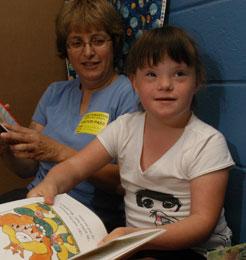
What you need to know
It is important to have HIGH LEARNING EXPECTATIONS for children who have Down Syndrome. Encourage use of the core educational curriculum and modify it in order to meet the individual needs of the child.
Children who have Down syndrome have a unique cognitive profile with specific strengths and challenges. Children who have Down syndrome can be included in their neighborhood schools. They may do well when extra supports are provided. Being with their peers is good for developing social and communication skills. Their team can make decisions about the need for specific instruction and pace.
- Intellectual Disability: The majority of Individuals have some degree of intellectual disability
- Most have mild to moderate intellectual impairment
- When learning, may learn more slowly and have difficulties with complex reasoning and judgment
- Delayed developmental milestones (i.e. walking and talking)
- Reach goals on their own pace
- They are often much stronger visual learners with strong visual memory, visual discrimination, and visual reasoning compared to their overall intellectual ability and their auditory processing.
- Children with DS do better with simultaneous processing than with sequential processing tasks. They can get the 'whole idea' but may have difficulty understanding a time sequence. In fact, time is a challenge for many.
- Children who have DS not only use self-talk to help themselves learn, but many seem almost incapable of silent thought.
- Those who are readers may have difficulty reading silently and need to do so out loud.
- Also, self-talk often involves the externalization of fantasy life. This can lead to embarrassing moments, and at worst, mistaken impressions that a child or youth is delusional or hallucinating as they audibly act out fantasy dialogues.
- They may be very distractible.
- Visual problems
- Poor muscle tone
- Mild to moderate hearing loss
- Possible cardiovascular irregularities
- Neck instability (AAI or atlantoaxial instability)
- This is a condition where there is increased mobility between the first and second cervical vertebra, allowing the vertebrae to slip out of alignment easily. This can cause damage to spinal cord.
- Language acquisition may be slow compared to age matched peers.
- Most children who have DS have an expressive language disability that is more significant than their receptive language or overall intellectual challenges.
- Low muscle tone can impact articulation and speech clarity. The child’s message may be distorted due to distortion (altering) and omission (leaving out) of speech sounds.
- Children with Down Syndrome often have difficulty with structure and organizing the order of words within a sentence. Constructing a sentence of increased length or complexity may be a challenge. Children may need guidance to recognize that sentences are grammatically correct.
What you can do
Each child should be looked at individually to find ideas that work for him or her. You may want to consider the following strategies and decide if any of these suggestions will work for the child. Strategies are adapted from the National Down Syndrome Society.
Interventions to support academic differences:
- Allow choice-making to build decision making skills
- Use routines to help learning
- Give clear signals about the end of one activity and the beginning of a new activity.
- Use picture symbols representing activities.
- Keep directions specific and brief
- Demonstrate skills to be learned
- Use concrete objects/manipulatives along with verbal explanations
- Use visual and auditory aids
- Visual materials are important.
- Reading might be approached initially using a sight reading method.
- Breakdown in small simple steps
- For reading, may rely on a whole word/site word approach rather than decoding the individual sounds in a word
- Use peer partners
- Use positive behavioral support strategies
- Provide positive reinforcement immediately
- Have high but realistic expectations
- Small group instruction may be more beneficial to the student than whole classroom
- Ask student to repeat or rephrase instructions
- Set aside time for review and practice of tasks
- Present only a few stimuli or objects at a time
- Be flexible with educational goals.
- Direct instruction in short periods of time
- Teach smaller chunks of activities
- Give new material slowly
- Teach in a sequentially and step-by-step fashion
- Minimize distractibility
- Keep away from windows
- Keep a structured environment
- Keep noise level down
- Have clear expectations, routines, and rules
- Individuals need x-rays before physical education because there are no symptoms.
- Individuals who have AAI (atlanto-axial instability) need to avoid any exercise/activity that puts pressure on the muscles of the neck.
- Gymnastics
- Diving
- Butterfly stroke
- The high jump
- Heading in soccer
- If a child is difficult to understand, a speech-language pathologist (SLP) may recommend use of an augmentative and alternative communication device and/or the continued use of sign language.
- These devices are programmed to the individual child to provide them with a voice and ensure that the child can relay messages to others.
- IPads are useful for many.
- An SLP can assist with speech clarity and rhythm of speech. An SLP can also assist with grammatical aspects of language in both spoken and written forms.
- Continued support through the school years will be important as literacy and pragmatic capabilities (the use of language for social communication) become increasingly important in the middle and high school years.
- Otitis Media is common in children with Down Syndrome and signs of ear infection should be closely monitored to ensure that the child is not missing out on valuable language input.
